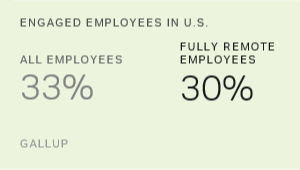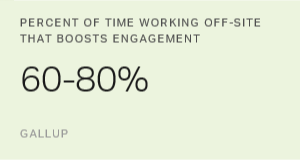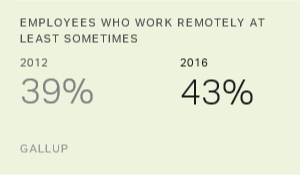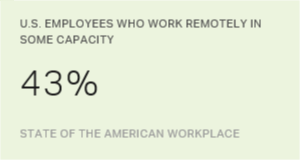Story Highlights
- Employees who work remotely 100% of the time are among the least engaged
- The best companies create structured processes to equip remote workers
- Managers are key to engaging and motivating remote employees
This is the third article in a four-part series.
Managers are increasingly supervising employees with whom they seldom have face-to-face interactions. Unfortunately, employees who work remotely 100% of the time are among the least .
Over the past four years in the U.S., the percentage of employees who work remotely 100% of the time has risen from 15% to 20%. This percentage will likely continue to grow as more organizations adjust their policies to attract and keep talented employees -- and as more employees require or demand this type of work arrangement.
Working from home can be advantageous to employees, allowing more flexibility in their workdays. Employers can also benefit, as they gain access to talented employees they may not have been able to attract for roles with traditional work arrangements.
The problem is that as a group, fully remote workers -- which could include work-from-home employees or those who have jobs that are mobile -- have the lowest levels of engagement of all remote workers. Their engagement is the same as that of employees on the opposite end of the spectrum -- those who never work remotely. Just 30% of employees in each group are engaged.
While their overall engagement levels are similar to the levels of those who are always in the office, fully remote workers eclipse nonremote workers on three engagement needs. According to Gallup's , fully remote workers are:
- 27% more likely than nonremote employees to strongly agree they have the materials and equipment they need to do their work right
- 31% more likely than nonremote employees to strongly agree they have the opportunity to do what they do best every day
- 17% more likely than nonremote employees to strongly agree they have a clear job description
Setting Fully Remote Employees Up for Success
Fully remote employees actually outscore all employees on the employee engagement survey item, "I have the materials and equipment I need to do my work right." This finding runs contrary to a common concern that fully remote work could increase the risk of employees not having what they need to fulfill their job responsibilities.
In Gallup's experience, organizations that offer successful remote working are quite disciplined in creating structured plans and processes to effectively equip their remote employees. At several well-known global companies the authors interviewed, employees who are new to the remote-working process receive a boxed set of all the materials and equipment necessary to start remote working. This includes all hardware/software, extra monitors, a printer, a desk and anything else employees would need in a traditional office setting.
Many of these companies provide help desks that are staffed 24 hours a day to service any questions from the field. They also fly employees to the company's headquarters so that the remote worker has the opportunity to meet and establish relationships with their coworkers. Some companies offer specific certification and in-depth training programs, while others have a "buddy system" to help new employees gain a thorough understanding of their roles.
Fully remote employees are 17% more likely than employees who work in the office 100% of the time to strongly agree they have a clear job description. This runs contrary to the popular belief that fully remote workers feel disconnected or don't have role clarity because they aren't in the office.
Gallup's research suggests that one reason why fully remote employees can find it easier to understand the demands of their job is effective management. Having a manager who can clearly communicate expectations and changes, build trust, and help break down barriers will greatly enhance a remote employee's experience. Freed from the stress of not understanding their roles or metrics, fully remote workers have more time to focus on their work and do what they do best.
Managers Are Key to Mastering the Remote Option
However, these findings don't mean that companies have mastered the "work-from-home" option. Much of what hinders the engagement of fully remote workers comes back to two critical performance factors: relationships and development.
Unlike those who balance time in and out of the office, fully remote workers don't have organic ways to interact with coworkers. This leads to lower engagement on employee survey items related to connecting with others and having opportunities to discuss progress and development. Managers also struggle to get to know their fully remote employees on a personal level, to understand their unique strengths and needs, and to effectively manage them.
Many managers have learned how to create a thriving virtual community that mirrors or even surpasses the office environment.
But for the most part, the data show that fully remote workers struggle to receive developmental guidance. Compared with the (those who work remotely 60% to less than 80% of the time), fully remote workers are:
- 35% less likely to strongly agree their coworkers provide them with meaningful feedback
- 30% less likely to strongly agree they have talked to their manager about steps to take to reach their goals in the past six months
Fully remote workers may have a foundation for success, but managers must make a continuous effort to motivate the performance of employees they never see.
It's not as easy for managers to stop these employees in the hallway to see how their days are going, give feedback or ask how they are progressing on projects. Without this constant contact, managers are faltering on providing fundamental development opportunities -- and perhaps increasing the risk that their fully remote employees will leave for better opportunities .
But if managers begin to intentionally grow their relationships with these employees, they might find themselves with a powerful group of high performers.
Managing with this intention will be the focus of the next article in this series.
To learn more about how to engage your remote workforce, we invite you to:
- the most recent State of the American Workplace report
- "Managing Your Remote Workers"



